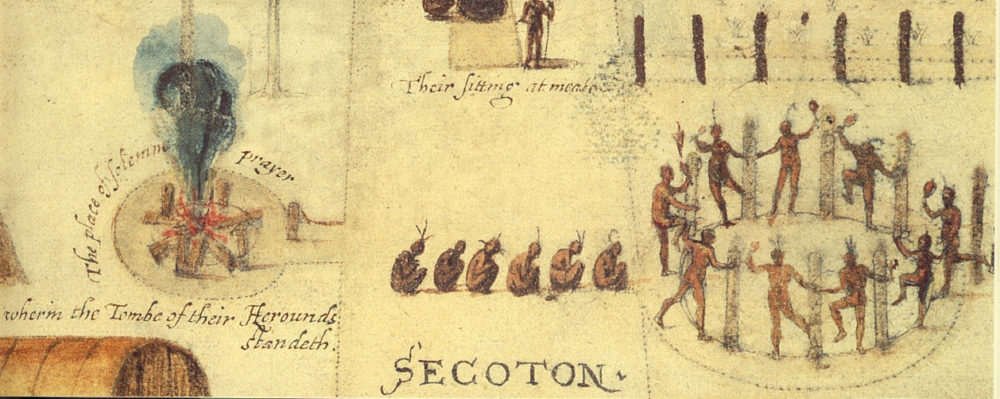
John White, “Village of the Secotan, 1585, via Wikimedia.
Introduction
The Columbian Exchange transformed both sides of the Atlantic with dramatically disparate results. New diseases wiped out entire civilizations in the Americas, while newly imported nutrient-rich foodstuffs enabled a European population boom. Spain benefited most immediately as the wealth of the Aztec and Incan Empires strengthened the Spanish monarchy. Spain used its new riches to gain an advantage over other European nations. But this advantage was soon contested. Portugal, France, the Netherlands, and England all raced to the New World, eager to match the gains of the Spanish. Native peoples greeted the new visitors with responses ranging from welcome cooperation to aggressive violence, but the ravages of disease and the possibility of new trading relationships enabled Europeans to create settlements all along the western rim of the Atlantic world. New empires would emerge from these tenuous beginnings, and by the end of the seventeenth century, Spain would lose its privileged position to its rivals. An age of colonization had begun and, with it, a great collision of cultures commenced. These sources chronicle the European challenges to Spain’s colonial dominance and the collisions between Europeans and Native Americans.
Documents
Richard Hakluyt used this document to persuade Queen Elizabeth I to devote more money and energy into encouraging English colonization. In twenty-one chapters, summarized here, Hakluyt emphasized the many benefits that England would receive by creating colonies in the Americas.
John Winthrop delivered the following sermon before he and his fellow settlers reached New England. The sermon is famous largely for its use of the phrase “a city on a hill,” used to describe the expectation that the Massachusetts Bay colony would shine like an example to the world. But Winthrop’s sermon also reveals how he expected Massachusetts to differ from the rest of the world.
John Lawson took detailed notes on the various peoples he encountered during his exploration of the Carolinas. Lawson recorded many aspects of Native American life and even noticed the progress of disease as it swept through native communities.
Chrestien Le Clercq traveled to New France as a missionary, but found that many Native Americans were not interested in adopting European cultural practices. In this document, LeClercq records the words of a Gaspesian man who explained why he believed that his way of life was superior to Le Clercq’s.
Most Native American peoples shared information solely through the spoken word. These oral cultures present unique challenges to historians, and force us to look beyond traditional written sources. Folk tales offer a valuable window into the ways that Native Americans understood themselves and the wider world. The Wampanoag legend of Moshup describes an ancient giant who lived on Martha’s Vineyard Island and offered stories about the history of the region.
These two documents explore the hysteria and death that captured Salem, Massachusetts at the end of the seventeenth century. In the first document, Sarah Carrier testifies that her mother forced her to engage in witchcraft. Her mother, Martha Carrier, was hung one week later. In the second document, Ann Putnam recants her own deadly accusations twenty years after the witchcraft trials.
In 1731, Manuel Trujillo accused two Pueblo men, Acensio Povia and Antonio Yuba, of committing sodomy. Both Povia and Yuba denied this accusation, and Yuba invoked his status as a Christian in order to bolster his credibility. Governor Gervasio Cruzat y Góngora chose to exile Povia and Yuba to different pueblos for a period of four months, during which time they were to cease any and all communication with one another. This case explores sexual practices deemed “nefarious sins” as well as illustrates what scholars have called the colonial dilemma—the situation where Indigenous peoples remained in a subjected state despite theological equality following their Christian conversion.
Media

Jean-Pierre Lassus, “Veüe et Perspective de la Nouvelle Orleans,” 1726, Centre des archives d’outre-mer, France via Wikimedia.
During the contact period, the frontier was constantly shifting and places that are now considered old were once tenuous settlements. This watercolor painting depicts New Orleans in 1726 when it was an 8-year-old French frontier settlement, nearly forty years prior to the Spanish acquisition of the Louisiana territory. In the foreground, enslaved Africans fell trees on land belonging to the Company of the Indies, and another enslaved man spears a massive alligator. Land has been cleared only just beyond the town limits and a wooden palisade provides meager protection from competing European empires.

An early sketch by settler John White of Native Americans in Virginia. Dancers are shown in a circle and others are sitting in a line. A fire is off to the left.
Native settlements were usually organized around political, economic, or religious activity. John White shows this Algonquin community engaged in some kind of celebration across from the fire he identified as “The place of solemne prayer,” indicating that ceremonial activity could be both solemn and raucous. In the center of the image, a communal meal has been laid alongside crops that are in varying stages of growth, suggesting the use of planting techniques like crop rotation. He also shows the interior of several longhouses, made of bent saplings and covered with bark and woven maps. Among the Powhatan, similar structures were called yehakins. In putting the longhouses and the settlement in a series of rows, White’s English perspective comes through: archaeological evidence shows that these houses were usually situated around communal gathering places or moved next to fields under cultivation not ordered in European-style rows.


